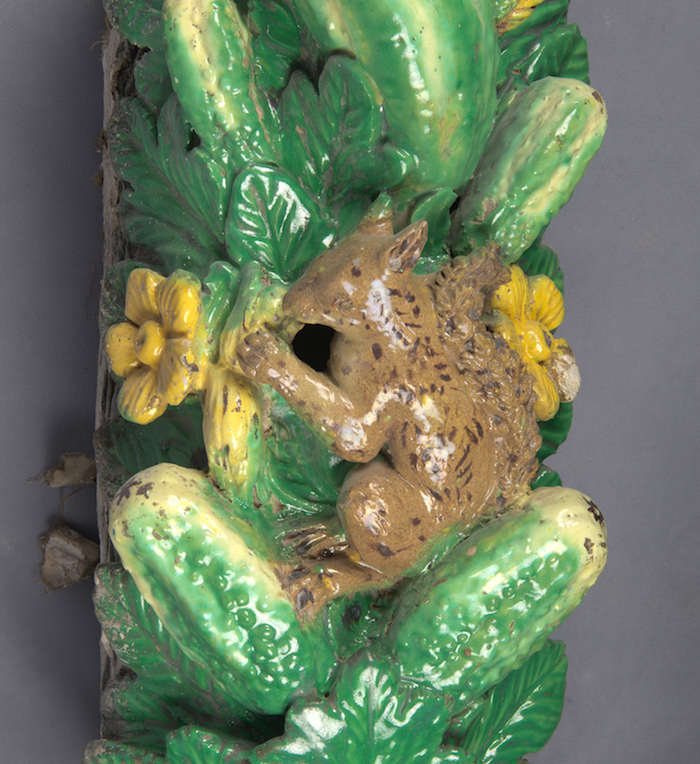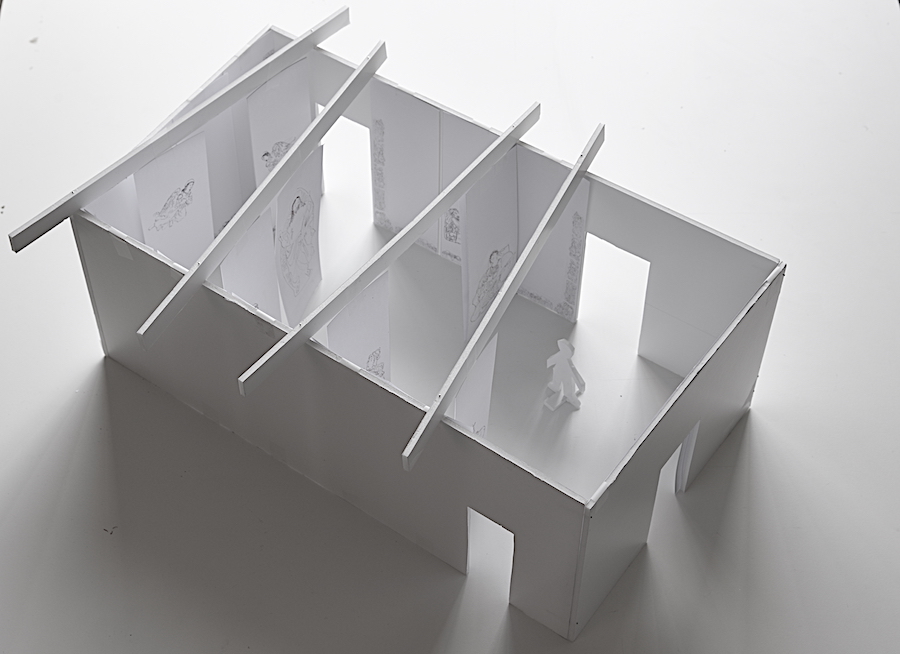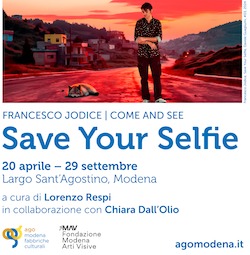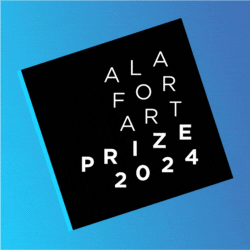
English text below
Il 9 novembre, rispettivamente al Museo del Bargello di Firenze e alla Cantina Antinori nel Chianti Classico (Bargino), si potranno ammirare i due interventi dell’artista Stefano Arienti, in relazione al capolavoro di Giovanni Della Robbia: la lunetta raffigurante “La resurrezione di Cristo” realizzata agli inizi del XVI secolo, su commissione di Nicolò Tommaso Antinori.
Nell’ambito di Antinori Art Project – a cura di Ilaria Bonacossa – l’artista di Asola, rilegge l’importante opera d’arte, oggi proprietà del Museo di Brooklyn, ma che torna a essere presentata al pubblico, dopo 500 anni, al Museo Nazionale del Bargello fino all’8 aprile 2018 a seguito di un importante restauro sostenuto negli Stati Uniti dalla famiglia Antinori.
Al Bargello, in una sala adiacente a quella della “La resurrezione di Cristo”, Arienti ha elaborato l’installazione “Scena Fissa”, dove i personaggi della lunetta sembrano muoversi in un teatro-giardino, come ci racconta l’artista nell’intervista che segue. Alla cantina Antinori, invece, è presentata una nuova installazione site-specific , “Altorilievo”: opera che entrerà a far parte della collezione di famiglia, attualizzando e rendendo visibile il forte legame con la storia e la tradizione mecenatistica. “Altorilievo”, nata per la Vinsataia della cantina, si articola come la scomposizione di un alto-rilievo scultoreo, in cui le figure della lunetta, rese monocrome, sono presentate nelle 46 campiture strutturali del capolavoro di della Robbia, in una rinnovata distribuzione spaziale delle figure.
Segue l’intervista con Stefano Arienti —
ATP: Mi racconti come hai elaborato le prime idee in relazione all’importante lunetta raffigurante “La resurrezione di Cristo” realizzata agli inizi del XVI secolo da Giovanni Della Robbia?
Stefano Arienti: Il primo approccio con quest’opera di Giovanni Della Robbia è avvenuto tramite immagini fotografiche, neanche così perfette. Si vedeva un’opera coloratissima, molto pittorica e affollatissima di personaggi, che non aveva niente da invidiare a molte immagini contemporaneee o pop spesso sovraccariche di figure e colore. Ma ho avuto anche la fortuna di poterla vedere dal vero al Brooklyn Museum, dove mi hanno gentilmente permesso di osservarla da molto vicino. E’ un’ opera composta da molte parti diverse che si incastrano assieme, così ho pensato che sarebbe stato interessante disarticolarla per poter ricostruire combinazioni differenti dei pezzi. Inoltre per differenziarmi dalla fattura rinascimentale con tutto il suo colore seducente ho provato a ridurre tutto ad un disegno monocromo, che provasse ad arrivare fino alle prime intuizioni di studio delle figure dell’autore.
ATP: In questa occasione proponi due progetti – “Scena Fissa” per il Museo Nazionale del Bargello e “Altorilievo” per la Cantina Antinori nel Chianti Classico – distinti ma in stretta relazione. Mi racconti i nessi tra i due progetti?
SA: Tutte e due le opere sono lo sviluppo divergente dello stesso materiale: le porzioni modellate che compongono la lunetta, una scena della resurrezione molto agitata dove solo il donatore Antinori ed un soldato addormentato, sono immobili.
“Scena Fissa” trasporta i personaggi che si accalcano nella lunetta in uno spazio più ampio, una specie di teatro-giardino dove possiamo muoverci a piacere a guardare fin dietro alle figure, e in qualche modo rispetta abbastanza la disposizione dei personaggi. Mentre “Altorilievo”, se nei fatti utilizza esattamente gli stessi disegni, in realtà li trasforma in pezzi tridimensionali distaccati, dove possiamo inventarci una relazione fra le parti. Questa seconda opera sta a parete invece che costruire un ambiente, e dovrebbe richiamare di più un insieme di frammenti archeologici che la descrizione di una scena.
ATP: Cosa intendi quando dici che bisogna entrare nelle immagini per “farle vivere diversamente, rendendole indipendenti dal passato ma anche da noi stessi”?
SA: Mi piace che le opere d’arte raggiungano una loro autonomia, frutto di una sana relazione col proprio pubblico più che con le intenzioni dell’autore. Da artista contemporaneo mi prendo il piacere di mostrare un modo possibile di relazione con opere del passato, un esempio di come riguardarle o permettere che abbiano una vita parallela nel presente, reincarnandosi fuori dalla loro teca di museo.
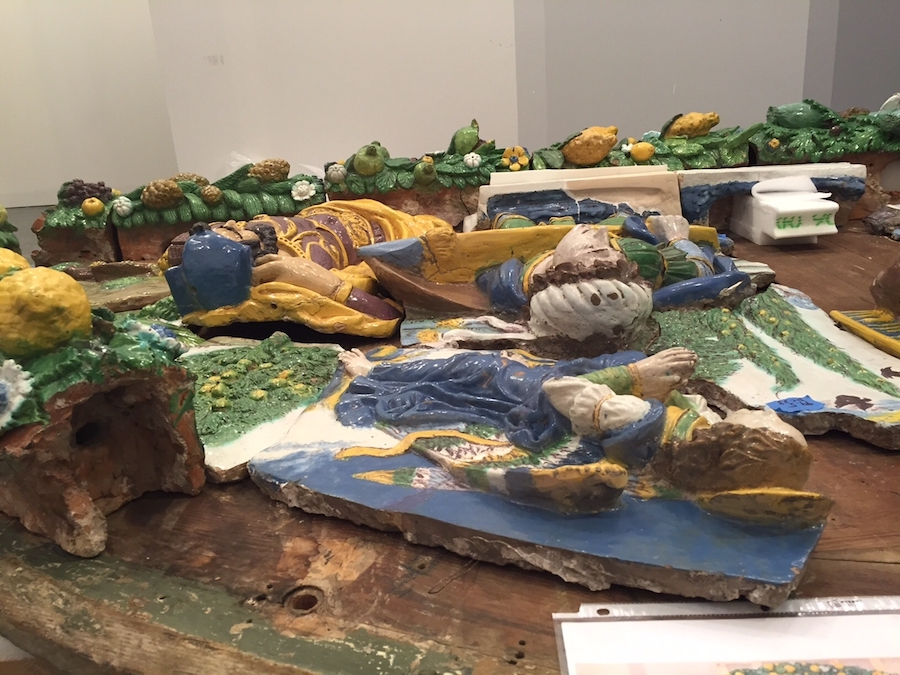
ATP: Per sviluppare le opere, sei partito proprio dallo studio del risultato del restauro della Lunetta. Cosa ti ha attratto del processo restaurativo?
SA: Guardando dal vero la lunetta a prima vista si è sopraffatti dal colore, dalla materia e dal movimento, dalla grande densità pittorica dell’insieme; poi si cominciano a distinguere nettamente le singole parti, che hanno anche proporzioni molto differenti, non pertinenti ad una visione prospettica dell’insieme. Si capisce che c’è un uso espressionistico delle forme che anticipa il grande teatro che si può vedere nei “Sacri monti”. Nel restauro è stata rimossa la matrice gessosa che legava assieme le singole parti, e che alla fine non è stata ripristinata. Proprio questo grande puzzle tridimensionale è la cosa che mi ha colpito di più.
ATP: Mi racconti come hai elaborato l’opera “Altorilievo”?
SA: La visita alla cantina di Bargino mi ha molto impressionato, e pensando ad una possibile collocazione di “Altorilievo” subito mi è molto piaciuto il locale della vinsantaia. Ho individuato una parete con profilo particolare frutto di una volta negativa che si abbassa verso il centro della sala, ha proprio l’andamento opposto a quello della lunetta e ne giustifica la dispersione dei frammenti su una superficie maggiore. Lo spazio un po’ oscuro e riflessivo, per fa riposare il vin santo; è perfetto per un’opera che finisce per essere più enigmatica di una semplice scena di carattere religioso. I frammenti sono scollegati e dobbiamo inventarci un paesaggio possibile dove ricollocarli.
ATP: Quest’ultima opera è installata negli spazi avveniristici della Cantina Antinori nel Chianti Classico. Quanto ti ha stimolato/condizionato questo ambiente fortemente strutturato? E’ stato complesso confrontarsi con questo spazio?
SA: Nonostante sia partito da una fonte lontana nel tempo con un’iconografia molto definita, il mio è un progetto del presente e mi trovo perfettamente a mio agio in una architettura contemporanea, anzi penso che possa accentuare il carattere del mio intervento. Mi piace la linea futuribile con colori e materie tradizionali, sobrietà ed eccentricità elegantemente assieme.

The masterpiece by Giovanni Della Robbia reinterpreted by Stefano Arienti.
The Antinori family, under the patronage of Antinori Art Project, have commissioned Stefano Arienti, (born in Asola, Italy, 1961), to develop a new project in dialogue with a historical Renaissance masterpiece: the lunette depicting the Resurrection of Christ, a sculptural relief by Giovanni Della Robbia (Florence, 1469-1529/30) commissioned by Niccolò di Tommaso Antinori in the early 16th century.
This lunette, referred to as the “Antinori lunette” by art historians, belongs to the Brooklyn Museum in New York and, after an absence of 500 years, will be publicly shown at the Bargello National Museum in Florence from November 9th 2017 to April 8th 2018. The relief has recently been restored in the United States with generous support from the Antinori family.
Stefano Arienti’s project is two fold; two separate yet complementary works of art, achieving a unique transformation and reinterpretation of the famous lunette.
Arienti’s piece titled “Scena Fissa” and the Antinori lunette will be exhibited in two adjoining galleries creating a direct dialogue between Renaissance and contemporary art in the exhibition “From Brooklyn to the Bargello: Giovanni Della Robbia, the Antinori Lunette and Stefano Arienti”.
At the same time, the state-of-the-art winery Antinori nel Chianti Classico will inaugurate a new site-specific installation by Arienti, “Altorilievo”, that will become part of the family’s permanent collection, accentuating their strong interest in history and renewing their legacy as patrons of the arts. The exhibition is curated by Ilaria Bonacossa
Interview with Stefano Arienti —
ATP: Could you tell me how you developed your initial ideas regarding the important lunette depicting The Resurrection of Christ, made in the early 16th century by Giovanni Della Robbia?
Stefano Arienti: My first contact with this work by Giovanni Della Robbia took the form of photographs, which were not all that good. It was evidently a very colourful work, very pictorial, crowded with figures, to the point that it could easily hold its own in a comparison with many contemporary or pop images, which are often overloaded with figures and colour.
But I was also lucky enough to be able to see it face to face at the Brooklyn Museum, where they kindly allowed me to observe it from close up. It is a work consisting of numerous parts that fit together, and so I thought that it would be interesting to disassemble it in order to reconstruct different combinations of the pieces. In addition, in order to move away from the Renaissance technique with all its seductive colour, I tried reducing everything to a monochrome drawing, to understand what could have been the artist’s initial ideas regarding the study of the figures.
ATP: On this occasion you are presenting two projects – “Scena Fissa” for Museo Nazionale del Bargello and “Altorilievo” for the Antinori Winery in the Chianti Classico district – separate but closely related. Could you tell me about the connections between the two projects?
SA: Both works are divergent developments of the same material: the modelled parts comprising the lunette, a very busy resurrection scene in which just the donor Antinori and a sleeping soldier are apparently motionless.
“Scena Fissa” transports the figures that are crowded into the lunette into a more spacious setting, a sort of garden-theatre where observers can move around as they like, even looking behind the figures, and to an extent it maintains the overall arrangement of the figures. While “Altorilievo” actually uses exactly the same drawings, in actual fact they are transformed into detached three-dimensional pieces, for which we can imagine a relation between the different parts. This second work is wall-mounted rather than constituting a setting, and the idea is that it recalls more a group of archaeological fragments than the description of a scene.
ATP: What do you mean when you say that you have to enter images in order to “bring them to life in a new way, making them different from the past but also with respect to ourselves”?
SA: I like it when works of art achieve their own independence, the result of a healthy relationship with the public, more than of the artist’s intentions. As a contemporary artist, I take pleasure in demonstrating a possible way of relating to works from the past, providing an example of how to look at them in a new way, or giving them a parallel existence in the present, reconstituting them outside their museum display case.
ATP: To develop the works, you began from a study of the results of the Lunette’s restoration. What attracted you in this operation?
SA: When you see the lunette face to face, you are overwhelmed by the colour, the material and the movement, the great pictorial density of the entire unit; and only then do you become aware of the individual parts, that may have very different proportions, with no relation to a perspective view of the group. You understand that forms have been used in an expressionist way, an anticipation of the highly theatrical compositions that you can see in the “Sacri monti” (Sacred Mountains). During the restoration, the plaster-based mortar binding the parts together was removed, and at the end of the restoration the components were not plastered together again. The thing that struck me most powerfully was this large three-dimensional puzzle.
ATP: Could you tell me how you developed the work “Altorilievo”?
SA: I was particularly impressed by my visit to the Bargino winery, and, thinking of a possible site for “Altorilievo”, I immediately liked the “vinsantaia”, the room for making Vin Santo. I identified a wall with an unusual profile, created by a negative vault that lowers towards the centre of the hall. It has exactly the opposite shape with respect to the lunette, and it provided a justification for spreading the fragments over a larger surface. The space is rather dark and meditative, ideal for ageing vin santo, and it is perfect for a work that ends up by being more enigmatic than just a simple religious scene. The fragments are separated and the observer has to invent a landscape in which to place them.
ATP: The work “Altorilievo” is installed in the futuristic spaces of the Cantina Antinori winery in the Chianti Classico district. What was your reaction to this location with its distinctive structures? Was it difficult to relate to this setting?
SA: Even though I started from a source far removed in time, with a well-defined iconography, my work is a project that belongs to the present, and I am perfectly at home in a contemporary architectural situation. In fact I think that this actually enhances the characteristics of my work. I like futuristic lines together with traditional colours and materials, sobriety and eccentricity elegantly combined.

